The SAT is coming up! Are you prepared? If you need to brush up on some of your math skills, then read on! In this lesson, we’ll go through 7 Important SAT Math Topics.
On the SAT, there are 58 questions divided between 20 no-calculator questions and 38 calculator questions. To do your absolute best on test day, make sure you understand the following topics.
Before launching into the topics, it’s worth noting that the SAT math covers topics in:
| Topic | Description |
| Heart of Algebra | Linear equations, systems of linear equations, linear inequalities, interpret variables and constants in linear expressions, graphs of linear equations |
| Problem Solving and Data Analysis | Ratios, percents, unit conversion, probability, statistics, linear vs. exponential growth, scatterplots, using linear, exponential, or quadratic models to describe how variables are related, measures of central tendency, 2-way tables, random samples, surveys |
| Passport to Advanced Mathematics | Quadratic or exponential models, radicals, rational exponents, function notation, relationship between factors and zeros, solving quadratic equations, systems of linear and quadratic equations, polynomials, graphs of polynomials |
| Additional Topics in Math | Trigonometry, complex numbers, congruent triangles, similar triangles, equations of circles, arc length, sector area, sine/cosine complementary angle relationship, volume and area, Pythagorean theorem |
Linear Functions
One of the most important concepts on the SAT math sections goes back to Algebra I: linear equations. For the SAT, you mainly need to know the slope-intercept form of a line and the standard form of a line. You’ll also need to know how to calculate slope.
Slope-intercept form:
- y=mx+b where m = slope and b= y-intercept
Standard Form of a line:
- Ax+By=C (slope = -A/B )
Slope of line between 2 points:
- m= (y2 – y1) / (x2 – x1) = rise/run
Often, you’ll encounter a question about parallel lines or perpendicular lines. It’s important to know the slope relationships in these situations.
| Slope Parallel Lines have the same slope. Perpendicular Lines have slopes that are negative (or opposite) reciprocals. That is, the slopes multiply to -1. For example, two lines with slopes 2 and -1/2 are perpendicular. |
EXAMPLE
In the xy-plane, line l has a slope of 3. Line k is perpendicular to line l and contains the point (6, 5). Which of the following is the equation of line k?
- A. y = -3x + 5
- B. y = -13x + 7
- C. y = -13x – 3
- D. y = -3x + 7
SOLUTION
To solve, we can use the fact that the slope of the perpendicular to l must be the opposite reciprocal of the slope of l. The opposite reciprocal of 3 is -⅓. Looking at the answer choices, we can eliminate choices A and D since these have slopes of -3. To determine the y-intercept of line k, we can plug in our point (6, 5) for x and y and solve for the y-intercept b.
- y = -13x + b
- 5 = -13(6) + b
- 5 = -2 + b
- 7= b
Hence, the equation of line k is y = -13x + 7. The correct answer is Choice B.
Parabolas/Quadratic Functions
Another important topic on the SAT is that of parabolas/quadratic functions. Recall that a quadratic function is a degree 2 polynomial such as the function y = 2×2 – 3x + 7. The graph of a quadratic function is a parabola. For the SAT, it’s important to be familiar with all 3 forms of a quadratic function, summarized here.
Standard Form: y = ax2 + bx + c
- if a>0 then the parabola opens up
- if a<0 then the parabola opens down
- (0, c) is the y-intercept
- -b/2a is the formula for the x-coordinate of the vertex
Vertex Form: y = a(x – h)2 + k
- where (h,k) is the vertex
- if a>0 then the parabola opens up
- if a<0 then the parabola opens down
Intercept Form (Factored Form): y = a(x – p)(x – q)
- if a>0 then the parabola opens up
- if a<0 then the parabola opens down
- (p,0) and (q, 0) are the x-intercepts
- To find the x-coordinate of the vertex, find the midpoint of the x-intercepts
EXAMPLE
In the xy-plane, the graph of the function f(x) = x2 – 7x – 8 has two x-intercepts. What is the distance between the x-intercepts?
- A. 10
- B. 9
- C. 8
- D. 7
SOLUTION
To solve this problem, we need to set our equation equal to zero and solve for x.
- x2 – 7x – 8 = 0
- (x – 8)(x + 1) = 0
- x = 8, x = -1
To find the distance between the two x-intercepts we can find the absolute value of the difference between the two points:
- |8 – -1| = 9
Thus, the distance between the x-intercepts is 9 units. The correct answer is choice B.
In the previous problem, we factored our quadratic to find the x-intercepts. Factoring is also an important skill that students need to know for the SAT. We’ll leave you to explore this topic on your own.
There may be a problem on the SAT where you’ll need to use the quadratic formula to solve the problem. You can often determine if a quadratic equation factors by looking at the answer choices. If every answer choice has a square root, you’ll need the quadratic formula.
Quadratic Formula: used to find the roots of ax2 + bx + c = 0
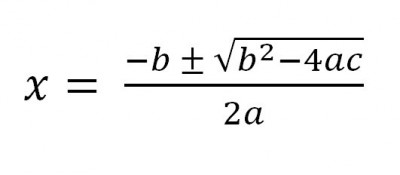
Systems of Equations
Systems of linear equations come up a LOT on the SAT. When you solve a system of linear equations, there are 3 possibilities for the number of solutions:
- One solution – the lines intersect. They have different slopes.
- No solution – the lines are parallel; they have the same slope but different y-intercepts.
- Infinitely many solutions– the two lines are the same! They have the same slope and the same y-intercept!
EXAMPLE
-2x+y = 8
ax + 5y = 1
- A.10
- B. 1
- C. -1
- D. -10
In the system of equations above, a is a constant. For which of the following values of a does the system have no solution?
SOLUTION
From our notes above, we know that for a system of linear equations to have no solution, the two lines are parallel. If the lines are parallel, they must have the same slope (and different y-intercepts.)
To determine our value of a, we can find the slope of the first equation using the slope formula -A/B where A is the coefficient of the x term and B is the coefficient of the y-term. In our example A = -2 and B = 1.
So the slope is -(-2)/1 = 2. Similarly, in the second equation the slope is equal to -a/5. We can set this fraction equal to 2 and solve:
- -a/5 = 2
- -a = 10
- a = -10
So, the correct answer is Choice D.
Probability/Statistics
A fair amount of SAT problems are devoted to probability and statistics. Here is a brief summary of important concepts.
| average (arithmetic mean) = (sum of the terms)/(number of terms) |
Note: on many SAT problems that involve averages, if you’re given the mean and the number of items, it’s VERY HELPFUL to find the sum of the terms.
- sum = average × (number of terms)
EXAMPLE
Sophie’s average on her first 4 history tests is 82%. What is the least grade she needs on the 5th test to improve her average to 85%?
SOLUTION
This problem can be solved using the sum of the test scores.
Sophie has: 4*82 = 328 points so far on her first 4 history tests. She needs a total of 585 = 425 points after the 5th test.
To determine the score she needs on the 5th test, we subtract 425 – 328 = 97. Hence, Sophie needs to earn 97% on her 5th exam to bring her average to an 85%.
| median – the middle value of the list (when put in ascending or descending order); if there is an even number of data items, find the two middle numbers and take the average of them. |
| mode – the value in a data list that occurs most often |
| probability of an event occurring = (number of desired outcomes)/(number of total outcomes) |
Circles
It’s important to review the equation for a circle in standard form. Often, students don’t know this formula so they can miss an easy question on test day!
Standard Form of a Circle: A circle centered at (h, k) with a radius of r :
- (x – h)2 + (y – k)2 = r2
EXAMPLE
Find the center of the circle with equation (x – 5)2 + (y – 5)2 = 16.
- A. (5, -3)
- B. (5, 3)
- C. (-5, -3)
- D. (-5, 3)
SOLUTION
This is an easy one if you know the formula! Since the equation is already in standard form, we can see that the center is (5, -3).
Notice, we always take the values that make the expression in parentheses equal to 0. The correct answer is Choice A.
Note: the problem didn’t ask for the radius but it’s worth noting that the radius is always the square root of the right side. In this case, the radius of the circle is 4.
Trigonometry
On the SAT, there will be a few questions involving trigonometry. Memorize the ratios below! There may be a question on unit circle trigonometry as well though we’re not going to cover that topic here.
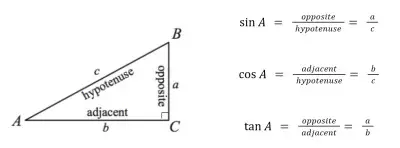
In addition to knowing how to use right triangle trigonometry and unit circle trigonometry, it’s useful to know this fact that the College Board seems to emphasize:
| The sine of an acute angle is equal to the cosine of the angle’s complement. sin x = cos (90-x) OR The cosine of an acute angle is equal to the sine of the angle’s complement. cos x = sin (90-x) |
EXAMPLE
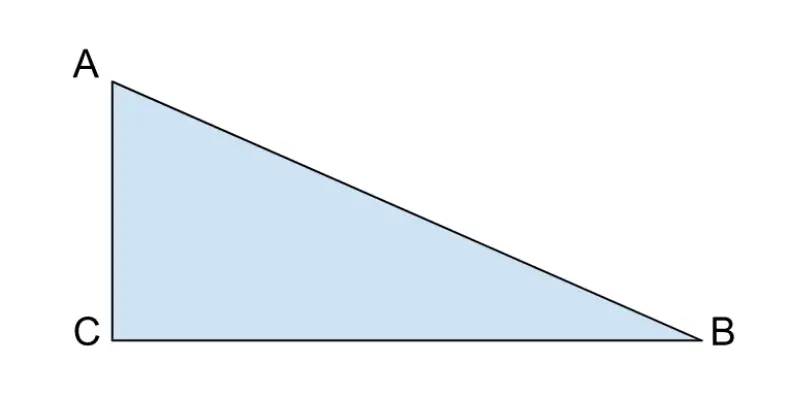
Right triangle ABC, shown above, has a right angle at vertex C. Which of the following values is equal to sin A?
- A. cos A
- B. sin B
- C. cos B
- D. tan B
SOLUTION
The acute angles of a right triangle are complementary; that is the sum of the measures of the angles add to 90 degrees.
We know the sine of an angle is equal to the cosine of the angle’s complement. In this case, A and B are complementary angles so the sin A = cos B. The correct answer is Choice C.
Exponential Growth and Decay
The College Board also places emphasis on exponential functions. Often, they will mix linear functions and exponential functions into the same problem.
| An exponential function with base b is defined by f(x) = abx where a ≠0, b > 0, b ≠1, and x is any real number. |
Note: The exponent x is the variable. The base b is a constant. The domain for the function is the real numbers and the range is the positive real numbers.

- a = initial value (the amount before measuring growth or decay)
- r = growth or decay rate (most often represented as a percentage and expressed as a decimal)
- t = number of time intervals that have passed
EXAMPLE
A researcher estimates that the population of a city is increasing at an annual rate of 0.4%. If the current population of the city is 70,000, which of the following expressions appropriately models the population of the city t years from now according to the researcher’s estimate?
- A) 70,000(1 + 0.004) t
- B) 70,000(1 + 0.4) t
- C) 70,000 + 1.4t
- D) 70,000(0.004)t
SOLUTION
Notice, because we have a situation with exponential growth, we can use our exponential growth model above. Looking at the answer choices, eliminate Choice C since it is a linear function, not an exponential function.
To accurately represent this expression, we need to convert 0.4% to a decimal. Move the decimal 2 places to the left, so we have r = 0.004. Our initial value is 70,000. Plugging in to the growth model, we get:
- 70,000(1 + 0.004)t
The correct answer is Choice A.
Geometry
Good news about SAT geometry: many geometry formulas are given to you on the SAT! The formulas cover area and volume formulas, as well as the Pythagorean Theorem and special right triangle ratios.
EXAMPLE
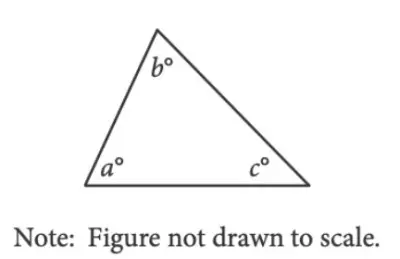
If c = 61 degrees, what is the value of a + b?
SOLUTION
This problem is relatively easy to figure out. The angles in a triangle add to 180 degrees. c = 61, then a + b= 180 – 61. Therefore, a + b =119 degrees.
EXAMPLE
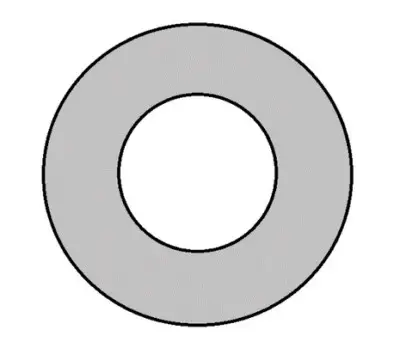
In the diagram above, the radius of the larger circle is 6 cm2 and the radius of the smaller circle is 4 cm2. Find the area of the shaded region.
- A. 16
- B. 20
- C. 36
- D. 52
SOLUTION
To find the area of the shaded region, subtract the area of the smaller circle from the area of the larger circle. The formula for the area of a circle is given to us on the SAT: A = πr2.
- Area of shaded region
- =π*62 – π*42
- =36π – 16π
- 20π
The area of the shaded region is 20π cm2. The correct answer is Choice B.
You can learn about the history of pi and how it is connected to circles here.
Final Note
There is a lot of math to know for the SAT! Hopefully, you’ll find these topics helpful as you prepare!
You can find part 2 of this SAT Math review article here.
You can learn about SAT Math scores and statistics here.
You can learn all about the new Digital SAT here.
I hope you found this article helpful. If so, please share it with someone who can use the information.
Don’t forget to subscribe to our YouTube channel & get updates on new math videos!
About the author:
Jean-Marie Gard is an independent math teacher and tutor based in Massachusetts. You can get in touch with Jean-Marie at https://testpreptoday.com/.



